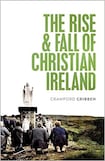
Independent TD Mattie McGrath sparked uproar when he compared Covid-19 Ireland – its pandemic restrictions and vaccination regimes – to the early political regime of Nazi Germany. Listening in from the land of the Nazi perpetrators, I wondered why he was reaching so far for his far-out historical comparison. If you view Ireland’s Covid-19 regime as draconian, arbitrary and discriminatory, why not compare it to the glory days of Catholic Ireland?
Perhaps because, as it vanishes over the horizon, we still have no social consensus over how we remember the country that once was ours. One section of Irish society denies Catholic Ireland was as bad as it is portrayed by the second group, which disowns ever being there, while a third and younger group looks on at a detached distance.
This is the reality gap into which Prof Crawford Gribben’s new book steps. The Rise & Fall of Christian Ireland is an ambitious academic attempt to condense 1,400 years of history into 220 pages, with 51 additional pages of footnotes and a 33-page bibliography.
Perhaps the greatest miracle of Irish Christianity is that it took root at all on this isolated island at the end of the known world. The earliest Christian settlers, the “Irish believing in Christ” to whom Pope Celestine I sent Palladius as bishop in 431, found in the island dwellers a people whose old beliefs were strong because, as Gribben points out, “they made sense of the Irish situation”.
But how to preach a new religion – communicated largely in Latin, a foreign language – to an illiterate people who had never before seen a book? That locals came on board – by choice, not force – was through a successful synthesis of old and new. Aside from its spiritual message, Christianity went mass market because it offered greater opportunities (wealth, education, trade) than what went before.
(Ironically, modern Ireland’s druids, who insist the early Christian church suppressed Celtic spiritual beliefs, have the early Irish Christian monks to thank for recording much of the Celtic spiritual traditions they now follow today.)
Despite beginning four centuries late, Ireland’s religious women and men caught up quickly and were soon producing world-class theological and scientific writings. As the Roman empire, christianised under Constantine, collapsed, Ireland’s protective Christian bubble thrived. By the 800s, so many Irish monks were now fanning out to rechristianise Europe that Heiric of Auxerre, a French Benedictine monk, complained that “almost the whole of Ireland . . . is migrating to our shores with a herd of philosophers”.
Back in Ireland, Christianity survived subsequent hostile centuries by being a “genuinely incorporating body”, Gribben argues, and one of the few common denominators among an increasingly diverse population. Even Sigtrygg Olafsson, the Norse-Irish King Sitric, converted to Christianity, made a Roman pilgrimage and vowed on his return to make Dublin a spiritual capital.
That the Reformation failed in Ireland, with just 120 Irish-born Protestants at the end of the 16th century, was attributed later by Catholic bishops as proof of their flock’s unshakeable belief in the one truth faith. Gribben sees other reasons, such as the Church of Ireland’s spectacularly poor salespeople. It took 98 years after Martin Luther’s 1517 theses before the established church produced its own localised sales pitch – “The Irish Articles” – by which time competing Presbyterians were already gaining ground.
The second half of Gribben’s story highlights the what-might-have-beens of Christianity in Ireland: almost a decade of self-government under the Catholic confederation until 1649; and the creative Christian chaos amid the bloody Cromwell years, when Ireland embraced charismatic child preachers and the cure for death discovered in Stradbally, Co Laois.
As the story reaches the modern day, the narrative achieves a Reeling in the Years pace that favours breadth over depth. Key events of Irish Christian history – the 1850 Synod of Thurles and the Eucharistic Congress of 1932 – are mentioned only in passing. The Marian apparition at Knock in 1879 gets one sentence and the landmark papal visit a century later, three. Curiously, Fr Michael Cleary gets a whole page.
Gribben’s repeated insistence that Christian Ireland is dead will jar with some, given that two-thirds of the population still identify as Catholic – if only culturally. That just a 10th of the 1979 papal visit numbers turned out for Pope Francis is “astonishingly low”, he argues. Seen another way, given the revelations of the previous decades, it was astonishingly high.
In the book’s final section, Gribben says Christianity’s expansionism had ruined the teachings of Christ long before they arrived in Ireland. Abuse survivors and their allies may nod but, given the undeniable achievements of Catholic religious in Ireland – in healthcare, education and more – some may find overly harsh his conclusion that “failure has marked the entire history of Christian Ireland”.
Derek Scally is Berlin correspondent for The Irish Times and author of The Best Catholics in the World











